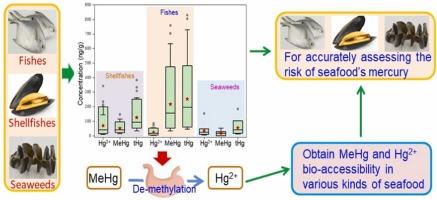The characteristic and bio-accessibility evaluation of mercury species in various kinds of seafood collected from Fujian of China for mercury risk assessment
IF 12.2
1区 环境科学与生态学
Q1 ENGINEERING, ENVIRONMENTAL
引用次数: 0
Abstract
Seafood consumption is the major source of total Hg (tHg) and methyl mercury (MeHg) for humans. Lack of broad-representative bio-accessibility of mercury species makes accurate assessment on health risk of seafood’s mercury impossible. Herein, the concentrations and in vitro bio-accessibilities of mercury species in 93 seafood samples with 71 different species were extensively investigated. Results indicated that all shellfish and fish samples, and most seaweed samples contained both Hg2+ and MeHg, while some seaweed samples contained only Hg2+. The concentrations of mercury species varied depending on the differences in species/individuals of seafood and sampling regions. MeHg in seafood can be partly de-methylated into Hg2+ during gastrointestinal digestion, which reduced the toxicity of mercury in seafood. The mean demethylation rate of MeHg varied as follows: seaweeds (⁓62.1%) > shellfishes/shrimps (⁓19.7%) > fishes (⁓9.2%). The mean bio-accessibility of Hg2+ and tHg varied as follows: seaweeds (⁓97.7% and ⁓90.1%) > shellfishes/shrimps (⁓65.1% and ⁓67.9%) ≈ fishes (⁓65.1% and ⁓66.7%), while that of MeHg varied as follows: fishes (⁓57.7%) > shellfishes/shrimps (50.8%) > seaweeds (⁓11.6%). The simulated calculation of target hazard quotient (THQ) revealed that the health risk of seafood’s mercury may be accurately assessed using tHg, not mercury species, even without considering bio-accessibility. This offers a simple but protective approach for assessing the health risk of seafood’s mercury. Results of this study provide the potential broad-representative bio-accessibilities of mercury species existing in various kinds of seafood and novel insights for scientifically assessing the health risk of seafood’s mercury and revising the mercury limitation in seafood.

从中国福建采集的各种海产品中汞物种的特征和生物可及性评价,用于汞风险评估
海产品是人类摄入总汞(tHg)和甲基汞(MeHg)的主要来源。由于缺乏具有广泛代表性的汞物种的生物亲和性,因此无法准确评估海产品中汞的健康风险。本文广泛研究了 71 个不同种类的 93 个海产品样本中汞的浓度和体外生物可及性。结果表明,所有贝类和鱼类样本以及大多数海藻样本都同时含有 Hg2+ 和 MeHg,而部分海藻样本仅含有 Hg2+。汞的种类浓度因海产品的种类/个体和采样地区的不同而异。海产中的甲基汞可在肠胃消化过程中部分脱甲基成为 Hg2+,从而降低海产中汞的毒性。甲基汞的平均脱甲基率变化如下:海藻类(⁓62.1%);贝类/虾类(⁓19.7%);鱼类(⁓9.2%)。Hg2+ 和 tHg 的平均生物可及性变化如下:海藻(⁓97.7% 和 ⁓90.1%)>;贝类/虾类(⁓65.1% 和 ⁓67.9%)≈鱼类(⁓18.1% 和 ⁓19.7%)>;鱼类(⁓9.2%)>。9%)≈鱼类(⁓65.1% 和⁓66.7%),而甲基汞的变化情况如下:鱼类(⁓57.7%)>;贝类/虾类(50.8%)>;海藻类(⁓11.6%)。目标危害商数(THQ)的模拟计算表明,即使不考虑生物可及性,海产品汞的健康风险也可以通过tHg而不是汞的种类来准确评估。这为评估海产品中汞的健康风险提供了一种简单但具有保护作用的方法。这项研究的结果提供了存在于各种海产品中的汞物种的潜在广泛代表性生物可及性,并为科学评估海产品汞的健康风险和修订海产品中汞的限制提供了新的见解。
本文章由计算机程序翻译,如有差异,请以英文原文为准。
求助全文
约1分钟内获得全文
求助全文
来源期刊

Journal of Hazardous Materials
工程技术-工程:环境
CiteScore
25.40
自引率
5.90%
发文量
3059
审稿时长
58 days
期刊介绍:
The Journal of Hazardous Materials serves as a global platform for promoting cutting-edge research in the field of Environmental Science and Engineering. Our publication features a wide range of articles, including full-length research papers, review articles, and perspectives, with the aim of enhancing our understanding of the dangers and risks associated with various materials concerning public health and the environment. It is important to note that the term "environmental contaminants" refers specifically to substances that pose hazardous effects through contamination, while excluding those that do not have such impacts on the environment or human health. Moreover, we emphasize the distinction between wastes and hazardous materials in order to provide further clarity on the scope of the journal. We have a keen interest in exploring specific compounds and microbial agents that have adverse effects on the environment.
 求助内容:
求助内容: 应助结果提醒方式:
应助结果提醒方式:


